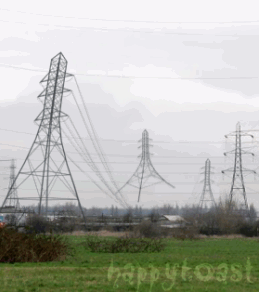Why You May Hear a Loud Boom When Watching This Silent GIF

What do you hear when you watch this GIF?
If you hear a loud boom each time the tower lands, you're not alone — but there isn't actually any sound accompanying the GIF.
The animated image, which has been making the rounds on Twitter recently, was created 10 years ago by HappyToast. The GIF shows three towers playing jump rope — the power lines spin around as the middle tower jumps over them. Each time it lands, the entire image shakes as though the tower were crashing down onto the ground. And even though the image is silent, many people report hearing a loud boom each time the legs of the tower land on the ground. [Top 10 Mysteries of the Mind]
The GIF was tweeted out on Dec. 2 by Lisa DeBruine, a neuroscientist at the University of Glasgow. In a follow-up tweet, DeBruine added a poll asking her followers what they could hear.
So, why do some people hear a sound when the tower crashes onto the ground?
The phenomenon may be explained by a condition called synesthesia, experts say. The condition causes different senses to be "mixed." For example, a person with synesthesia may taste sounds or hear colors. But another form of synesthesia, "hearing-motion" synesthesia, could explain "hearing" the GIF, several experts told Live Science.
The GIF seems to be causing some kind of "cross-modality cognitive effect," meaning that people's brains are internally combining vision with the perception of sound, said James Simmons, a neuroscientist at Brown University who studies bat echolocation.
Sign up for the Live Science daily newsletter now
Get the world’s most fascinating discoveries delivered straight to your inbox.
Robert Froemke, a neuroscientist at NYU Langone Health, told Live Science that it's not entirely clear why this happens. One possible explanation for the mixed sensations is that "usually, visual inputs like [the GIF] are highly correlated with a physical sensation of a 'thud,' that we hear and feel, and we learn or come to expect that from our experiences," he said. In other words, because people expect to hear the thud, they hear it.
"Hearing-motion" synesthesia may be a side effect of living in a noisy world, said Christopher Fassnidge, a doctoral candidate at City, University of London. Fassnidge's research has suggested that as many as one in five people have this type of synesthesia, making it much more common than other forms.
This sort of sensory crossover may be more common because people are constantly surrounded by a noisy world, and they've come to expect that certain sounds will accompany certain visuals, like a clapping hand, Fassnidge told Live Science. So because people have come to expect that a large structure slamming into the ground hard enough to make the ground shake — as portrayed in the GIF — would be accompanied by a loud boom, the brain fills in the missing sensation, he said.
For people who don't hear anything while watching the GIF, research suggests that this is because certain connections among different sensory regions are inhibited in their brain, Fassnidge said. But for those who do hear something, those connections aren't blocked off. "This means, when the visual parts of our brain process movement, these connections to the auditory areas are free to fire, which can result in the illusion of sound," he said.
So, when it comes to this "noisy" GIF, there's not really a sound. But because people's experiences and ingrained knowledge of how the world works so strongly demand a loud boom, the brain fills in the gaps.
Editor's note: The reporter was a research intern in Simmons' lab in 2013.
Original article on Live Science .










